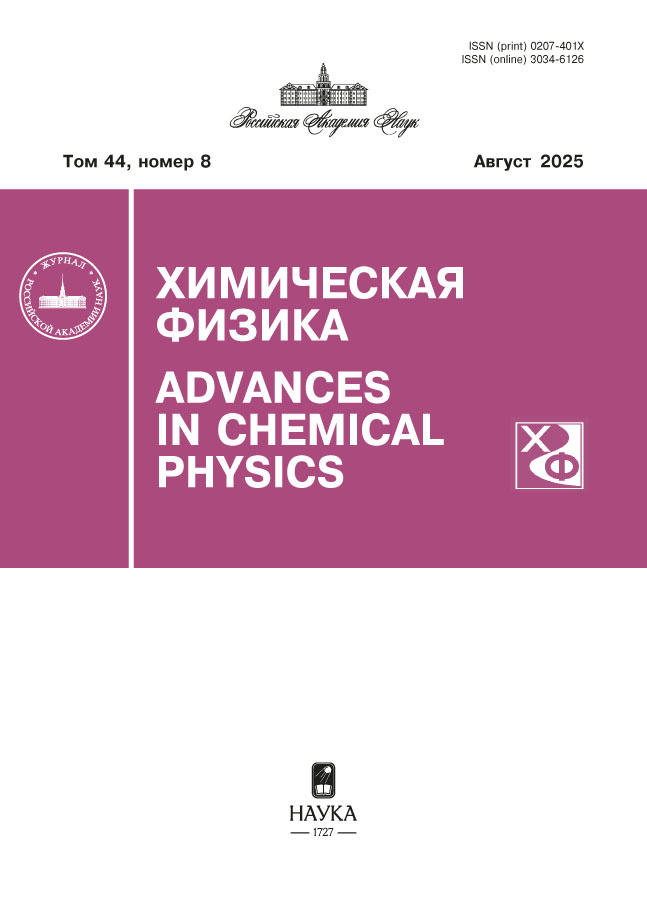Фрагментация гетероциклических молекул при захвате одного электрона двухзарядными ионами
- Авторы: Басалаев А.А.1, Кузьмичев В.В.1, Панов М.Н.1, Симон К.В.1, Смирнов О.В.1
-
Учреждения:
- Физико-технический институт им. А.Ф. Иоффе Российской академии наук
- Выпуск: Том 43, № 12 (2024)
- Страницы: 3-15
- Раздел: Элементарные физико-химические процессы
- URL: https://medjrf.com/0207-401X/article/view/684173
- DOI: https://doi.org/10.31857/S0207401X24120018
- ID: 684173
Цитировать
Полный текст
Аннотация
Методом времяпролетной масс-спектрометрии исследованы процессы фрагментации ионов аденина (Ade, C5H5N5) и циклодиглицина (DKP, C4H6N2O2), образующихся в процессах захвата одного электрона при взаимодействии молекул, находящихся в газовой фазе, с ионами C2+ и O2+ с энергией 12 кэВ. Экспериментально обнаруженная зависимость относительного сечения фрагментации молекулярных ионов от вида налетающего иона качественно объяснена в рамках квазимолекулярной модели. Многоконфигурационным методом самосогласованного поля в полном активном пространстве (CASSCF) выполнены расчеты путей экспериментально наблюдаемых реакций фрагментации ионов Ade+ и DKP+. Вычисленные значения энергии появления фрагментов хорошо согласуются с имеющимися в литературе экспериментальными данными.
Полный текст
Об авторах
А. А. Басалаев
Физико-технический институт им. А.Ф. Иоффе Российской академии наук
Автор, ответственный за переписку.
Email: a.basalaev@mail.ioffe.ru
Россия, Санкт-Петербург
В. В. Кузьмичев
Физико-технический институт им. А.Ф. Иоффе Российской академии наук
Email: a.basalaev@mail.ioffe.ru
Россия, Санкт-Петербург
М. Н. Панов
Физико-технический институт им. А.Ф. Иоффе Российской академии наук
Email: a.basalaev@mail.ioffe.ru
Россия, Санкт-Петербург
К. В. Симон
Физико-технический институт им. А.Ф. Иоффе Российской академии наук
Email: a.basalaev@mail.ioffe.ru
Россия, Санкт-Петербург
О. В. Смирнов
Физико-технический институт им. А.Ф. Иоффе Российской академии наук
Email: a.basalaev@mail.ioffe.ru
Россия, Санкт-Петербург
Список литературы
- Jochims H.-W., Schwell M., Baumgärtel H. et al. // Chem. Phys. 2005. V. 314. № 1–3. P. 263. https://doi.org/10.1016/j.chemphys.2005.03.008
- Pilling S., Lago A.F., Coutinho L.H. et al. // Rapid Commun. Mass Spectrom. 2007. V. 21. № 22. P. 3646. https://doi.org/10.1002/rcm.3259
- Barreiro-Lage D., Bolognesi P., Chiarinelli J. et al. // J. Phys. Chem. Lett. 2021. V. 12. № 30. P. 7379. https://doi.org/10.1021/acs.jpclett.1c01788
- Chiarinelli J., D. Barreiro-Lage D., Bolognesi P. et al. // Phys. Chem. Chem. Phys. 2022. V. 24. P. 5855. https://doi.org/10.1039/D1CP05811H
- Barreiro-Lage D., Chiarinelli J., Bolognesi P. et al. // Ibid. 2023. V. 25. № 23. P. 15635. https://doi.org/10.1039/D3CP00608E
- Feil S., Gluch K., Matt-Leubner S. et al. // J. Phys. B: At. Mol. Opt. Phys. 2004 V. 37(15). № 3013. https://doi.org/10.1088/0953-4075/37/15/001
- Dawley M.M., Tanzer K., Cantrell W.A. et al. // Phys. Chem. Chem. Phys. 2014. V. 16. № 45. P. 25039. https://doi.org/10.1039/C4CP03452J
- Van der Burgt P.J.M., Finnegan S., Eden S. // Eur. Phys. J. D. 2015. V. 69. № 173. https://doi.org/10.1140/epjd/e2015-60200-y
- Li B., Ma X., Zhu X. L. et al. // J. Phys. B: At. Mol. Opt. Phys. 2009. V. 42(7). № 075204. https://doi.org/10.1088/0953-4075/42/7/075204
- De Vries J., Hoekstra R., Morgenstern R. et al. // Ibid. 2002. V. 35(21). № 4373. https://doi.org/10.1088/0953-4075/35/21/304
- Tabet J., Eden S., Feil S. et al. // Intern. J. Mass Spectrom. 2010. V. 292. № 1. P. 53. https://doi.org/10.1016/j.ijms.2010.03.002
- Afrosimov V.V., Basalaev A.A., Vasyutinskii O.S. et al. // Eur. Phys. J. D. 2015. V. 69. № 3. https://doi.org/10.1140/epjd/e2014-50435-5
- Басалаев А.А., Кузьмичев В.В., Панов М Н. и др. // Письма в ЖТФ. 2022. Т. 48. № 17. С. 13. https://doi.org/10.21883/PJTF.2022.17.53280.19238
- Basalaev A.A., Kuz’michev V.V., Panov M.N. et al. // Radiat. Phys. Chem. 2022. V. 193(4). № 109984. https://doi.org/10.1016/j.radphyschem.2022.109984
- Басалаев А.А., Кузьмичев В.В., Панов М.Н. и др. // ЖТФ. 2022. Т. 92. № 7. С. 978. https://doi.org/10.21883/JTF.2022.07.52654.309-21
- Barca G.M.J., Bertoni C., Carrington L. et al. // J. Chem. Phys. 2020. V. 152(15) № 154102. https://doi.org/10.1063/5.0005188
- Дьяков Ю.А., Адамсон С.О., Ванг П.К. и др. // Хим. физика. 2021. Т. 40. № 10. С. 22. https://doi.org/10.31857/S0207401X21100034
- Дьяков Ю.А., Адамсон С.О., Ванг П.К. и др. // Хим. физика. 2022. Т. 41. № 6. С. 85. https://doi.org/10.31857/S0207401X22060036
- Храпковский Г.М., Аристов И.В., Егоров Д.Л. и др. // Хим. физика. 2022. Т. 41. № 9. С. 19. https://doi.org/10.31857/S0207401X22070068
- Басалаев А.А., Кузьмичев В.В., Панов М.Н. и др. // Хим. физика. 2023. Т. 42. № 10. С. 16. https://doi.org/10.31857/S0207401X23100035
- Hush N.S., Cheung A.S. // Chem. Phys. Lett. 1975. V. 34. P. 11.
- Hwang C.T., Stumpf C.L., Yu Y.-Q. et al. // Intern. J. Mass Spectrom. 1999. V. 182/183. P. 253.
- Russo N., Toscano M., Grand A. // J. Comput. Chem. 2000. V. 21. № 14. P. 1243.
- Improta R., Scalmani G., Barone V. // Intern. J. Mass Spectrom. 2000. V. 201. P. 321.
- Janev R.K., Presnyakov L.P. // Phys. Rep. 1981. V. 70. № 1. P. 1. https://doi.org/10.1016/0370-1573(81)90161-7
- Lin J., Yu C., Peng S., Akiyama I. et al. // J. Amer. Chem. Soc. 1980. V. 102. P. 4627.
- Trofimov A.B., Schirmer J., Kobychev V.B. et al. // J. Phys. B: At. Mol. Opt. Phys. 2006. V. 39. № 2. P. 305. https://doi.org/10.1088/0953-4075/39/2/007
- Arachchilage A.P.W., Wang F., Feyer V. et al. // J. Chem. Phys. 2010. V. 133(17). № 174319. https://doi.org/10.1063/1.3499740
- Franz J., Gianturco F.A. // Eur. Phys. J. D. 2014. V. 68. P. 279. https://doi.org/10.1140/epjd/e2014-50072-0
- Kramida A., Ralchenko Yu., Reader J. et al. // NIST Atomic Spectra Database (version 5.9). 2021. https://doi.org/10.18434/T4W30F
Дополнительные файлы

















